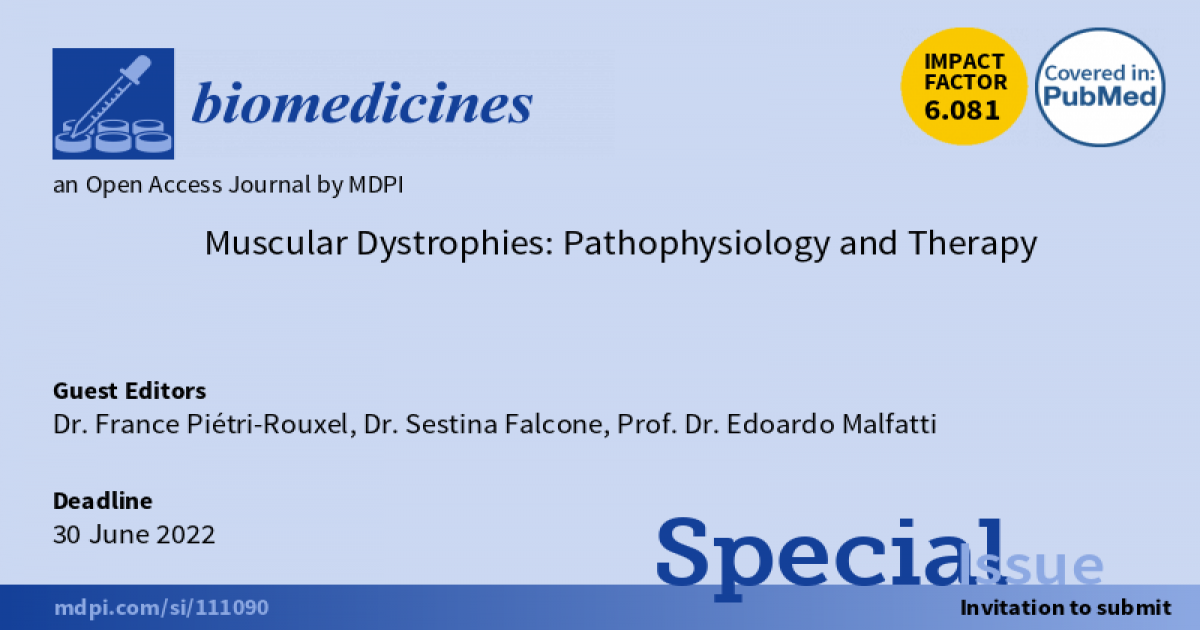- 3.9Impact Factor
- 6.8CiteScore
- 18 daysTime to First Decision
Muscular Dystrophies: Pathophysiology and Therapy
This special issue belongs to the section “Molecular and Translational Medicine“.
Special Issue Information
Dear Colleagues,
This Special Issue, "Muscular Dystrophies: Pathophysiology and Therapy", will focus on the pathophysiological mechanisms underlying muscular dystrophies, new animal models and methodological approaches for studying muscle dysfunction/recovery, as well as the development of innovative therapeutic strategies and ongoing clinical trials.
Muscular dystrophies are a heterogeneous group of muscle disorders that cause the progressive weakening and breakdown of skeletal/cardiac muscles over time. The diseases differ in their genetic origins, the muscles affected, outcome severity and the onset of symptoms. Among over 35 different muscular dystrophies, Duchenne muscular dystrophy accounts for nearly 50% of cases, all of which are caused by familial or spontaneous mutations of genes coding for proteins involved in muscle development or function. The loss or dysfunction of these proteins can lead to increased muscle membrane fragility, calcium alterations and protease activation, the release of pro-inflammatory cytokines, and impaired mitochondrial metabolism.
To date, no muscular dystrophies have a curative treatment available to patients. Standards of care help to slow the loss of function and breakdown of muscles, including anti-inflammatory measures, as well as respiratory and cardiac support. Corticosteroids are the first-line treatment for DMD, but they are associated with significant secondary effects.
Therapeutic strategies that address the root cause of these diseases are currently being developed for a handful of muscular dystrophies, including virus-based gene therapy and antisense drugs. In this context, the activation of the host immune system against the transgene or viral capsid, the route of administration and the accurately targeted tissue, in order to achieve the restoration of fully functional muscle in patients, remains a challenge. Therefore, strategies that aim to rescue altered proteins, as well as animal models and methodologies, must be optimized. These must be improved to achieve robust readouts, allowing the validation of treatment efficacy in clinical trials. This Special Issue is open to research studies, ranging from basic to preclinical approaches, and will also cover original articles and reviews.
Dr. France Piétri-Rouxel
Dr. Sestina Falcone
Prof. Dr. Edoardo Malfatti
Guest Editors
Manuscript Submission Information
Manuscripts should be submitted online at www.mdpi.com by registering and logging in to this website. Once you are registered, click here to go to the submission form. Manuscripts can be submitted until the deadline. All submissions that pass pre-check are peer-reviewed. Accepted papers will be published continuously in the journal (as soon as accepted) and will be listed together on the special issue website. Research articles, review articles as well as short communications are invited. For planned papers, a title and short abstract (about 250 words) can be sent to the Editorial Office for assessment.
Submitted manuscripts should not have been published previously, nor be under consideration for publication elsewhere (except conference proceedings papers). All manuscripts are thoroughly refereed through a single-blind peer-review process. A guide for authors and other relevant information for submission of manuscripts is available on the Instructions for Authors page. Biomedicines is an international peer-reviewed open access monthly journal published by MDPI.
Please visit the Instructions for Authors page before submitting a manuscript. The Article Processing Charge (APC) for publication in this open access journal is 2600 CHF (Swiss Francs). Submitted papers should be well formatted and use good English. Authors may use MDPI's English editing service prior to publication or during author revisions.
Keywords
- dystrophies
- therapeutic strategies
- innovative methodologies and animal models
- pathophysiology and target molecules

Benefits of Publishing in a Special Issue
- Ease of navigation: Grouping papers by topic helps scholars navigate broad scope journals more efficiently.
- Greater discoverability: Special Issues support the reach and impact of scientific research. Articles in Special Issues are more discoverable and cited more frequently.
- Expansion of research network: Special Issues facilitate connections among authors, fostering scientific collaborations.
- External promotion: Articles in Special Issues are often promoted through the journal's social media, increasing their visibility.
- e-Book format: Special Issues with more than 10 articles can be published as dedicated e-books, ensuring wide and rapid dissemination.

